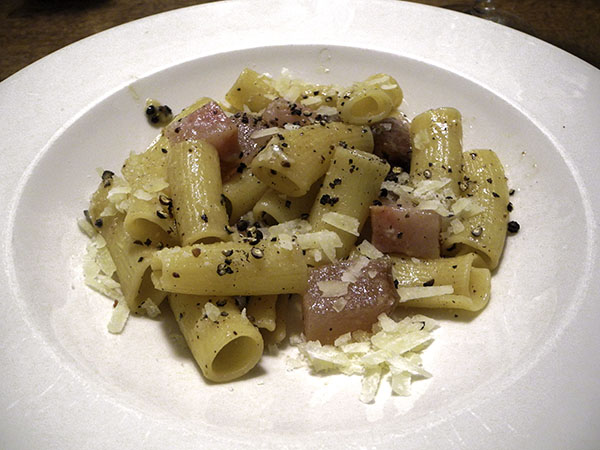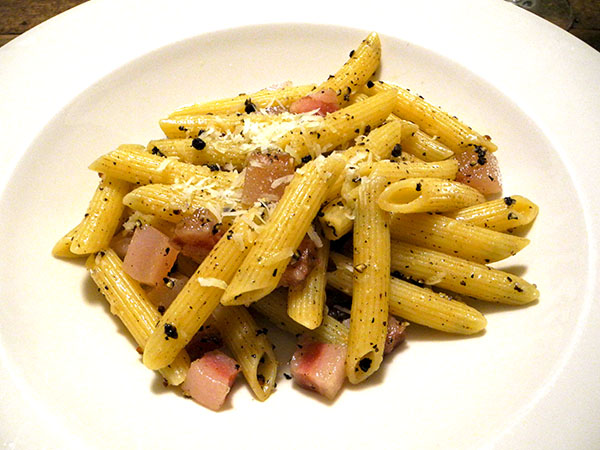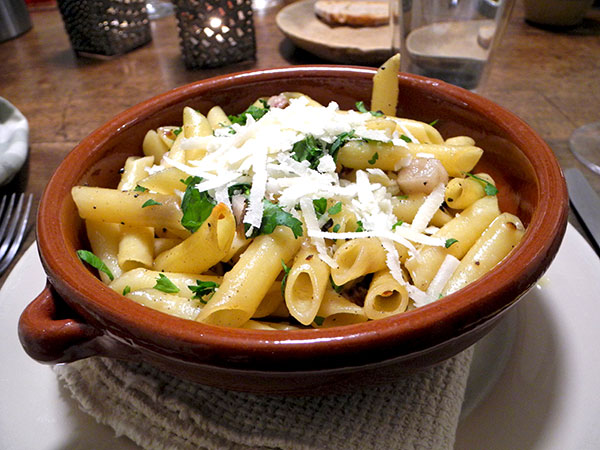
“la cucina de na vorta”
We’ve been enjoying this simple pasta from Lazio for decades, and I highly recommend it to anyone who appreciates a delicious, genuinely honest dish, dalla cucina dei poveri, with a surprising sophistication but a simplicity that allows it to be fully assembled and on the table in only about 15 minutes.
There are only 6 ingredients (4 if you discount salt and pepper), and the only one most people may not have lying around at home might be pancetta or, better, guanciale, to which I’d add for those who aren’t vegetarian, ‘and why isn’t it there’? It’s so easy to keep a chunk of guanciale in the freezer, and if it’s hard to find, pancetta is almost as good, but it must be in chunk form. On Sunday I had some ‘pancetta pepato‘ for the first time ever; I don’t know where it fits on the beautiful scale that stretches between regular pancetta and guanciale, but it was pretty awesome,
My relationship with this dish started in 1989, with a newspaper article by Fred Plotkin published in the New York Times, and Barry and I have shared it many times since, both at home in New York, and in Rome, dining outside the piccola trattoria, ‘da Lucia‘, the Trastevere restaurant featured in Fred’s article, where Lucia Antonangeli began serving “la cucina de na vorta” (the cooking of once upon a time) at her family’s restaurant in 1938.
It’s one of the very few recipes I use to which I never add or subtract a thing; it’s perfect, and it’s a classic in the classic sense. The only variation that will ever be found in our home is the type of pasta used: Will it be long or short, and which long, which short? From what I have learned the choice seems to be debatable anyway.
- last night I cooked 10 ounces of Setaro spaghetti from Buon Italia in a large stainless steel pot of water, to which almost 2 tablespoons of sea salt had first been added, until the pasta was barely al dente, reserving some of the liquid, drained it and and tossed it into a large enameled cast iron pot in which (while the spaghetti was boiling) 5 ounces of ‘pancetta pepato’ from Buon Italia, cut in 1/2 to 1 inch square pieces, had been heated and stirred with 2 tablespoons of Whole Foods Market Portuguese house olive oil for only about a minute, then, once guanciale and pasta had been mixed together, a bit of pasta water added to the pot and everything stirred for a minute to emulsify the sauce; several tablespoons [yes!] of very good freshly-ground Whole Foods house black pepper added and stirred into the mix, which was then removed from the heat and about 3 or 4 tablespoons of roughly-shredded pecorino Romano Sini Fulvi, also from Buon Italia, tossed into the pot and stirred, the pasta left standing for 30 seconds or so before it was served in shallow bowls, with more cheese and black pepper on the side
- the wine was a California (Lodi) white, F. Stephen Millier Angels Reserve White Blend Lodi 2016 (“..insane amounts of peach and ripe apricot flavors inside thanks [to] Stephen’s Pinot Grigio, Moscato, Chard, Viognier and Symphony grapes..”), from Naked Wines
- the music was Mendelssohn’s Symphony No 2 ‘Lobgesang’, Sir John Eliot Gardiner conducting the London Symphony Orchestra



 Years ago we used to enjoy this, what I will call ‘perfect meal’, very often, but, maybe because it’s been so long since we were in Italy, or maybe because I’ve become obsessed with cooking local fish, La Gricia seems to have made
Years ago we used to enjoy this, what I will call ‘perfect meal’, very often, but, maybe because it’s been so long since we were in Italy, or maybe because I’ve become obsessed with cooking local fish, La Gricia seems to have made 